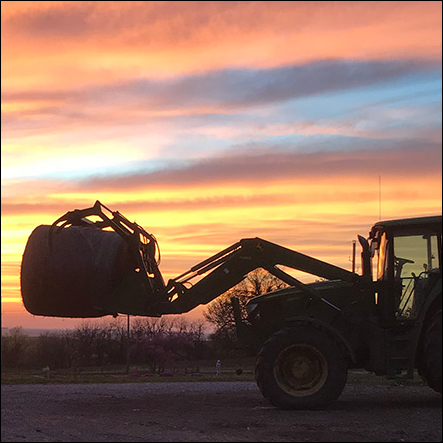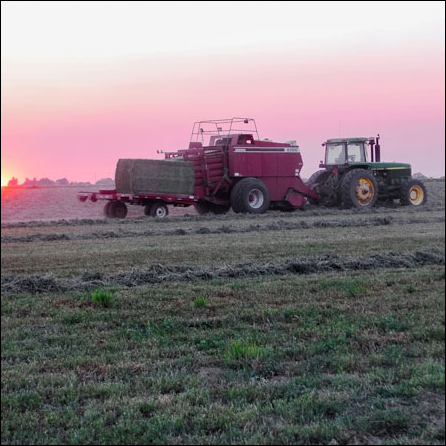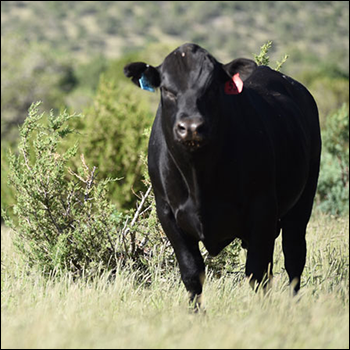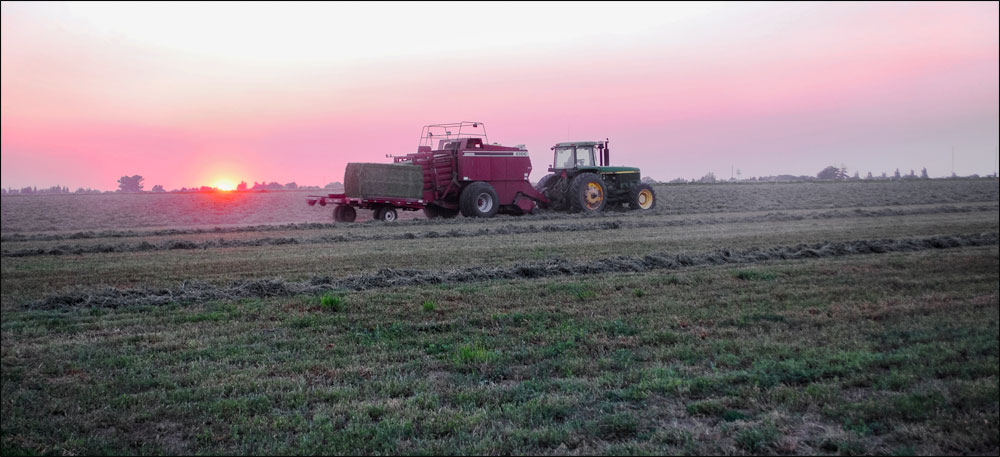
Have a Hay Day
Tips on timing when harvesting hay.
The difference between good-quality hay and poor is primarily in timing of harvest. Poor harvesting conditions and methods can also change a good crop to a poor one.
Glenn Shewmaker, state forage specialist with the University of Idaho, says stage of harvest is crucial. Mature hay works for some classes of animals, but for weaned calves or cows with calves, you need early-cut immature plants that are higher in protein. Overly mature or weather-damaged hay can generally only be used by dry beef cows.
Kevin Sedivec, professor in the range science program at North Dakota State University, says harvest strategy is different for grass hay than for alfalfa, or mixed grass and alfalfa.
Grass hay
“The best time to cut grass hay is just after boot stage, right before heading, to optimize quantity and quality,” explains Sedivec. “We did research on cutting grasses looking at timing, and cut a different piece every two weeks. By the heading stage (which is just after boot stage and before seed-set), you have about 90% to 95% of the potential growth of that plant. Quality is still fairly high. Protein level at that stage is 9% to 10% (depending on the type of grass), and this is what you’d need for a lactating beef cow,” he says.
This stage of growth occurs earlier in southern regions and later in northern regions with a shorter growing season and depends a little on the year, he says.
“If you wait until seed-set stage, you might gain 5% more production, but quality drops from 9% or 10% protein level down to about 6% or 7%, which is only adequate for a dry cow,” he says.
If the fields are not too dry yet, grasses regrow faster if you cut them at that stage, and there will be more regrowth for fall pasture. Once the plant starts to produce seed, it puts all its energy into seed production instead of leaf production, he explains. It won’t regrow much.
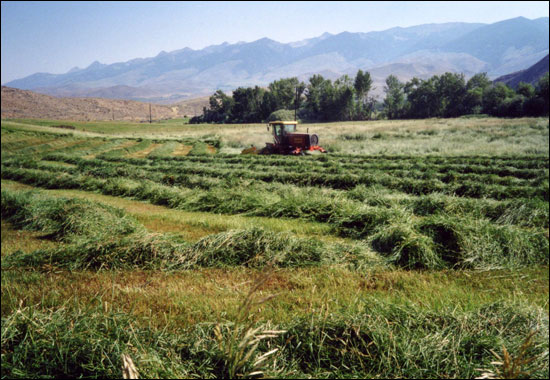
“The best time to cut grass hay is just after boot stage, right before heading, to optimize quantity and quality,” explains Kevin Sedivec. [Photo by Heather Smith Thomas] |
If you cut it before the heading stage, it will still try to regrow leaf tissue, because it wants to grow and produce seed. Sedivec admits the best time to cut grass for quality is the boot stage, but you give up about 30% of growth. It’s better to compromise a little quality to get more tonnage, waiting until just before it heads, and still get regrowth.
The time of day you cut grass also makes a difference on quality, especially sugar content. Sugar will be higher when cut in the evening than when cut in the morning, Sedivec says.
Shewmaker explains that plants accumulate sugars and starches during the day through photosynthesis, then use up these nutrients at night as they grow. Time of day can also be a factor for humidity. Dew in the morning could make it too wet to cut in the morning.
Alfalfa
“If you want dairy-quality alfalfa, cut it at bud stage — ahead of blooms. You give up biomass (quantity and tonnage) when you cut it early, but if you cut at bud stage, you almost always gain an extra cutting later in the season unless weather is too dry,” Sedivec says.
“Rule of thumb when cutting alfalfa for beef cattle is to cut when it’s about 10% bloomed,” says Sedivec. “But if it’s 10% bloomed, it can be 20% by the next day. When I see one bloom, it’s time to cut! You give up a little quality for beef cattle once it starts to bloom, but relative feed value will still be in the upper 140 to 150 range, versus 175 to 190 if it’s still in the bud stage,” he says.
At first bloom, you only give up about 10% of potential biomass. Don’t wait any longer because once it starts to bloom it gets more stem and there’s more leaf shatter when baling, warns Sedivec.
When hay is that mature, it’s imperative to watch timing of baling to make sure it’s not too dry. He says the sweet spot is enough humidity to keep the leaves on, but not so much moisture the hay will mold. That may mean baling in the evening just as dew comes on, and quit when dew gets heavy.
Shewmaker says some producers use moisture meters to check hay and determine when to bale a field, though some who’ve been putting up hay for a long time can assess moisture levels in the hay just by feeling the stems.
“We recommend using a moisture meter, but most are designed for bales rather than windrows. One of my colleagues developed a tool made from PVC pipe, which compresses samples from a windrow. You can use this probe to measure moisture before you take a baler into the field. You can also go by feel, scratching the cuticle on the stems, or various twisting-and-snap tests to check stem dryness,” says Shewmaker.
Grass-alfalfa mix
Sedivec recommends cutting mixed hay based on maturity of the alfalfa, not the grass.
“When you start to see alfalfa bloom, it should be cut, even though the grass won’t be quite ready. You give up some biomass on the grass. If you wait until that first bloom of alfalfa, you give up about 20% of potential biomass for the grass, but still have a high-quality feed for almost any class of livestock,” Sedivec says.
Editor’s note: Heather Smith Thomas is a cattlewoman and freelance writer from Salmon, Idaho. Lead photo courtesy Glenn Shewmaker.
